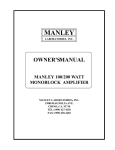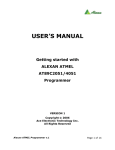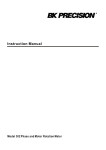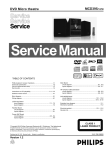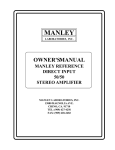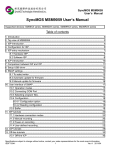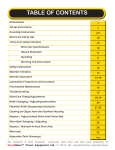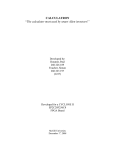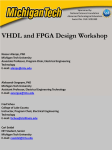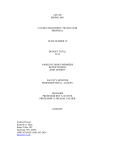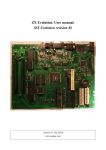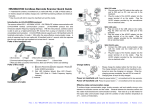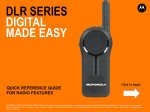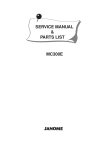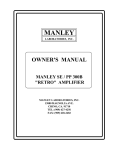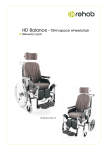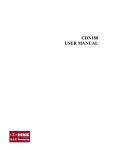Download Z80 Microprocessor Kit User`s manual
Transcript
Z80 Microprocessor Kit User's manual Rev. 1.1, October 2015 Z80 MICROPROCESSOR KIT USER'S MANUAL CONTENTS OVERVIEW...........................................................................................3 FUNCTIONAL BLOCK DIAGARM........................................................3 HARDWARE LAYOUT...........................................................................4 KEYBOARD LAYOUT............................................................................5 HARDWARE FEATURES......................................................................6 MEMORY AND I/O MAPS......................................................................6 GPIO1 LED.............................................................................................7 CONNECTING Z80 KIT TO TERMINAL................................................8 EXPANSION BUS HEADER..................................................................9 10ms TICK GENERATOR....................................................................10 RS232C PORT......................................................................................11 DATA FRAME for UART COMMUNICATION......................................11 CONNECTING LCD MODULE.............................................................12 LOGIC PROBE POWER SUPPLY........................................................12 HARDWARE SCHEMATIC, BOM, AND PCB LAYOUT.......................13 OVERVIEW The Z80 microprocessor kit is a single board microcomputer designed for self learning. Students will learn how to build the computer using the 1976, Z80 microprocessor with memory and simple I/O chips. The kit can be assembled at home without the need of special tools. The kit itself is the real microcomputer. Students will learn how to program the Z80 microprocessor in machine language with instruction hex code. The hex code can be entered to memory and tested it directly. Results of CPU operations can be checked in the memory or user registers display easily. The kit manuals are 1) user's manual for hardware details, 2) programming lab book and 3) construction guide for kit assemble steps. Z80 KIT FUNCTIONAL BLOCK DIAGRAM RS232C 32kB User RAM Interfacing bus expansion 2400 Bit/s UART 4kB Monitor ROM PLD decoder Z80 Microprocessor 1.79MHz Oscillator AC adapter +5VDC power supply 10ms tick generator 16x2 Text LCD module 6-digit 7-segment display Keyboard, hex key, functions key and CPU control key 8-bit debugging LED Logic speake Probe +5V supply r Notes 1. UART is software control for low speed asynchronous communication. 2. LCD module is optional, the kit provides a 16-pin header. 3. 10ms Tick generator is for a maskable interrupt source. NMI is used by single stepping circuit. 3 HARDWARE LAYOUT RS232C connector, DB9 male DC jack, +9VDC GPIO1 LED, 8-bit binary display (address is 40H) LCD contrast adj. 20-pin Text LCD header. Selector for 10ms tick or INTR key Important Notes 1. Plugging or removing the LCD module must be done when the kit is powered off! 2. AC adapter should provide approx. +9VDC, higher voltage will cause the voltage regulator chip, U9 becomes hot. 3. The kit has diode protection for wrong polarity of adapter jack. If the center pin is not the positive (+), the diode will reverse bias, preventing wrong polarity to feed to voltage regulator. 4 KEYBOARD LAYOUT HEX keys Hexadecimal number 0 to F with associated user registers and flag bits when press REG CPU control keys RESET MON INTR USER Reset the CPU, Z80 will begin fetch the code from location 0000 Force CPU to jump back to monitor program Make INT pin to logic low, used for experimenting with interrupt process User key for lab test, active low Monitor function keys INS Insert byte to memory, current byte will be shifting down. DEL Delete current byte, the next byte will be shifting up. STEP Execute user code only single instruction and return to save CPU registers GO Jump from monitor program to user code SBR Set break address CBR Clear break address PC Set current display address with user Program Counter REG Display user registers or flags with HEX key for a given register. DATA ADDR Set entry mode of hex keys to Data field Set entry mode of hex keys to Address field 5 COPY Copy block of memory, used with key + for Start, End, Destination and key GO REL Compute relative byte, used with key + for Start, Destination and key GO SEND Send Intel hex file at 2400 bit/s using serial port LOAD Load Intel hex file at 2400 bit/s using serial port HARDWARE FEATURES • • • • • • • • • • Microprocessor: Zilog Z80 @1.79MHz, 40-pin DIP package Memory: 4kB monitor ROM, 32KB user RAM Memory& I/O Decoder logic: GAL16V8 System tick: 10ms produced by AT89C2051 microcontroller GPIO: 8-bit LED display DISPLAY: 6-digit super bright 7-segment display Keypad: 36-key Serial port: 2400 Bit/s RS232C using software controlled UART Expansion slot: 40-pin header LCD bus: 16x2 text display direct bus interface MEMORY AND I/O MAP The Z80 kit has separated memory and I/O space. Memory space is selected with MREQ signal, I/O space with IORQ signal. The bank areas for both memory and I/O are available for experimenting. 256 bytes I/O 64kB Memory 0000H 0FFFH 1000H 4kB Monitor ROM 32kB RAM 8FFFH FFFFH 00H 01H 02H PORT0 PORT1 40H GPIO1 PORT2 80H 81H LCD command WR LCD data WR 82H 83H LCD command RD C0HC3H LCD data RD User 6 GPIO1 LED The Z80 kit provides a useful 8-bit binary display. It can be used to debug the program or code running demonstration. The I/O address is 40H. U16 is 8-bit data latch. Logic 1 at the output will make LED lit. The GPIO1 LED can be used to display accumulator register easily. Let us take a look the sample code below. Address Hex code 1800 3E 01 1802 D3 40 Label MAIN Instruction comment LD A,1 Load register A with 1 OUT (40H),A Write A to GPIO1@ 40H The test code has only two instructions. Each instruction has machine code of two bytes. Enter the hex code to memory from 1800 to 1803. Then press PC, and execute the instruction with single step by pressing key STEP. The 2nd pressed STEP key that executes instruction out (40H),A will make the GPIO1 LED showing the content of register A. Another sample is with JUMP instruction. The JUMP instruction will change the Program Counter to 1800, to repeat program running. Address Hex code 1800 3C 1801 D3 40 1803 C3 00 18 Label MAIN Instruction comment INC A Increment register A OUT (40H),A Write A to GPIO1@ 40H JP MAIN Jump back to main Again enter the hex code to memory and test it with single step. Every time when instruction out(40H),A was executed, did you see the LED display changed? We will learn more the use of GPIO1 with Z80 Programming Lab Book. 7 CONNECTING Z80 KIT TO TERMINAL All of monitor commands are compatible with MPF-1, except SEND and LOAD keys. For LOAD key, we can connect the Z80 kit to a terminal by RS232C cross cable. You may download free terminal program, teraterm from this URL, http://ttssh2.sourceforge.jp/index.html.en RS232C cross cable VT100 Terminal Z80 Kit The example shows connecting laptop with COM1 port to the RS232C port of the Z80 kit. To download Intel hex file that generated from the assembler or c compiler, set serial port speed to 2400 bit/s, 8-data bit, no parity, no flow control, one stop bit. 8 Press key LOAD, then key GO. The kit will wait for the data stream from terminal. On PC, Click file>Send File>LED.HEX. The kit will read the hex file, write to memory, when completed the start message will be displayed. SEND key will need Start, End address then press GO, the kit will send Intel hex file to terminal. EXPANSION BUS HEADER JP1, 40-pin header provides CPU bus signals for expansion or I/O interfacing. Students may learn how to make the simple I/O port, interfacing to Analog-to-Digital Converter, interfacing to stepper motor or AC power circuits. USER KEY User key, S19 is one bit active low key switch connected to bit 6 of Port 0. To test the logic of S19, we can use IN A,(0) and check bit 6 of the accumulator with test bit instruction. 9 10ms TICK GENERATOR SW4 is a selector for interrupt source between key INTR or 10ms tick produced by 89C2051 microcontroller. Tick generator is software controlled using timer0 interrupt in the 89C2051 chip. The active low tick signal is sent to P3.7. For tick running indicator, P1.7 drives D15 LED. Tick is a 10ms periodic signal for triggering the Z80 interrupt pin. When select SW4 to Tick, the Z80 CPU can be triggered by a maskable interrupt. The 100Hz tick or 10ms tick can be used to produce tasks that executed with multiple of tick. The Z80 kit lab look will show how to use 10ms tick to make a digital timer. 10ms 10ms 10ms 10 RS232C PORT The RS232C port is for serial communication. We can use a cross cable or null MODEM cable to connect between the kit and terminal, or kit #1 to kit #2 for sending or receiving hex file. The connector for both sides are DB9 female. We may build it or buying from computer stores. For new PC or laptop computer with USB port, we may have the RS232C port by using the USB to RS232 converter. DATA FRAME for UART COMMUNICATION Serial data that communicated between kit and terminal is asynchronous format. The Z80 kit has no UART chip, instead it uses software controlled to produce bit rate of 2400 bit/s. The data frame is composed of start bit, 8-data bit and stop bit. For our kit, period = 1/2400 = 417 microseconds. Since bit period is provided by machine cycle delay. Thus to send/receive serial data correctly, all interrupts must be disabled. 11 CONNECTING LCD MODULE JR1 is 20-pin header for connecting the LCD module. The example shows connecting the 16x2 lines text LCD module. R17 is a current limit resistor for back-light. R18 is trimmer POT for contrast adjustment. The LCD module is interfaced to the Z80 bus directly. The command and data registers are located in I/O space having address from 80H to 83H. Be advised that plugging or removing the LCD module must be done when the kit is powered off. Text LCD module accepts ASCII codes for displaying the message on screen. Without settings the LCD by software, no characters will be displayed. The first line will be black line by adjusting the R18 for contrast adjustment. LOGIC PROBE POWER SUPPLY The kit provides test points TP1(+5V) and TP2(GND) for using the logic probe. Students may learn digital logic signals with logic probe easily. The important signals are RESET (TP4) and CPU clock (TP3). Tick signal, however indicated by D15 LED blinking. Logic probe can test it at P3.7 of the 89C2051 microcontroller directly. Red clip is for +5V and Black clip for GND. + 5V at TP1 GND at TP1 12 HARDWARE SCHEMATIC, PARTS LIST AND PCB LAYOUT C1 100pF SW1 U4A 74LS14 R1 1k R3 10k C2 10uF R8 10k 2 U4D Y1 8 11 12 3 3.579MHz 74LS14 +5V U4B VCC 1k R2 74LS14 D CLK VCC 14 1 2 3 6 7 Q 4 Q U7 A B R0(1) R0(2) R9(1) R9(2) 74LS90 C9 0.1uF XTAL U5B 9 12 9 8 11 74HC74 8 QA QB QC QD RESET VCC C10 0.1uF TXD XTAL 4 VCC 2 3 VCC + 5 RESET C5 10uF 16V C11 0.1uF D 20 1 5 4 2 3 6 7 8 9 VCC Q Q TP4 1 U5A 5 CPU_CLK 1 TP3 3 27 CLK M1 28 19 20 22 21 RFSH 24 6 WAIT U1 M1 MREQ IORQ WR RD REFSH HALT WAIT INT NMI RESET BUSRQ BUSAK CLK Z80 R6 10k WAIT 1 + select INTR source 3 2k C6 1000uF 16V R10 Tick 100Hz R19 680 2 SW4 BUSRQ 6 25 23 26 16 17 VCC INT VCC D3 POWER 1 C13 0.1uF VIN U9 LM7805/TO LED D15 R4 10k CPU_CLK BUSRQ BUSAK INT HALT MREQ IORQ WR RD R5 10k 18 *RESET NMI 12 13 14 15 16 17 18 19 VOUT 11 74HC74 RESET 6 3 P3.7 P1.0/AIN0 P1.1/AIN1 P1.2 P1.3 P1.4 P1.5 P1.6 P1.7 Programmable timer C12 0.1uF AT89C2051 VCC RST/VPP XTAL1 XTAL2 P3.0/RXD P3.1/TXD P3.2/INTO P3.3/INT1 P3.4/T0 P3.5/T1 U8 74LS14 U4C CLK 4 PR CL 1 5 1 M1 + VCC VCC BREAK + 9 C7 C8 0.1uF VSS 29 D C RESET C3 C18 100nF 0.1uF 3 A0 A1 A2 A3 A4 A5 A6 A7 A8 A9 A10 A11 A12 A13 A14 A15 D0 D1 D2 D3 D4 D5 D6 D7 30 31 32 33 34 35 36 37 38 39 40 1 2 3 4 5 14 15 12 8 7 9 10 13 D0 D1 D2 D3 D4 D5 D6 D7 MREQ IORQ A6 A7 A12 A13 A14 A15 A0 A1 INTR SW2 A12 A13 A14 A15 1 2 U6 I I I I I I I I 10 9 8 7 6 5 4 3 25 24 21 23 2 26 22 20 27 1 I/CLK I/OE U2 27C64/27C256 12 13 14 15 16 17 18 19 R9 1k +5V Date: Size B Title 11 12 13 15 16 17 18 19 D0 D1 D2 D3 D4 D5 D6 D7 VCC + GPIO1 A0 A1 A2 A3 A4 A5 A6 A7 A8 A9 A10 A11 A12 A13 A14 20 22 27 10 9 8 7 6 5 4 3 25 24 21 23 2 26 1 D0 D1 D2 D3 D4 D5 D6 D7 U3 1 D0 D1 D2 D3 D4 D5 D6 D7 D0 D1 D2 D3 D4 D5 D6 D7 HM62256B A0 A1 A2 A3 A4 A5 A6 A7 A8 A9 A10 A11 A12 A13 A14 WR RD CE OE WE 0x1000-0x8FFF JP1 2 4 6 8 10 12 14 16 18 20 22 24 26 28 30 32 34 36 38 40 1 HEADER 20X2 1 3 5 7 9 11 13 15 17 19 21 23 25 27 29 31 33 35 37 39 1 Sheet Expansion Bus WR RD RAMCE RD WR LCD_E PORT0 PORT1 PORT2 A11 A12 A13 A14 A15 CPU_CLK D4 D3 D5 D6 D2 D7 D0 C4 100uF D1 INT NMI HALT MREQ IORQ VCC VCC Saturday, January 17, 2015 Document Number <Doc> Z80 MICROPROCESSOR KIT HALT ROMCE RAMCE A0 A1 O0 A2 O1 A3 O2 A4 O3 A5 O4 A6 O5 A7 O6 A8 O7 A9 A10 A11 A12 A13 OE CE PGM VPP 0x0000-0x0FFF (4kB) I/O/Q I/O/Q I/O/Q I/O/Q I/O/Q I/O/Q I/O/Q I/O/Q 2 LED D1 R7 680 GAL16V8B VCC 2 DC input BC557 Q1 1 11 2 3 4 5 6 7 8 9 RD ROMCE VCC J1 A0 A1 A0 A1 A2 A3 A4 A5 A6 A7 A8 A9 A10 A11 1 TVS5V_SOD123 D2 1N4007 D4 VCC 2 DC2 3 1 10uF SW3 MONITOR TP1 +5V 1 TP2 1 4 2 B A GND 5 GND 2 PR 10 CL 13 11 12 13 15 16 17 18 19 3 D0 D1 D2 D3 D4 D5 D6 D7 RD WR BUSAK WAIT BUSRQ *RESET M1 RFSH A0 A1 A2 A3 A4 A5 A6 A7 A8 A9 A10 of Rev 2 D C B A D C B A WR D0 D1 D2 D3 D4 D5 D6 D7 1 2 D0 D1 D2 D3 D4 D5 D6 D7 U13A 4001 9 8 RESET WR PORT1 PORT2 RD PORT0 3 U13C 4001 5 5 D0 D1 D2 D3 D4 D5 D6 D7 D0 D1 D2 D3 D4 D5 D6 D7 D0 D1 D2 D3 D4 D5 D6 D7 10 U13B +5V 5 6 4001 13 VCC VCC U4F 2 3 4 5 6 7 8 9 11 1 20 2 3 4 5 6 7 8 9 11 1 20 4 18 17 16 15 14 13 12 11 1 19 74LS14 U12 1Q 2Q 3Q 4Q 5Q 6Q 7Q 8Q 0x02 VCC 1D 2D 3D 4D 5D 6D 7D 8D LE OE VCC 0x01 74HC573 U14 1Q 2Q 3Q 4Q 5Q 6Q 7Q 8Q 0x01 1D 2D 3D 4D 5D 6D 7D 8D LE OE U15 A1 A2 A3 A4 A5 A6 A7 A8 19 18 17 16 15 14 13 12 19 18 17 16 15 14 13 12 20 2 3 4 5 6 7 8 9 TXD 74HC573 VCC 0x00 Y1 Y2 Y3 Y4 Y5 Y6 Y7 Y8 G1 G2 VCC 74HC541 12 E G F A B C DP D PA0 PA1 PA2 PA3 PA4 PA5 PA6 11 4 S19 PC7 SPEAKER VCC VCC RXD 4 PC0 PC1 PC2 PC3 PC4 PC5 PC6 A B C D E F G DP U4E 74LS14 10 14 16 13 3 5 11 15 7 U10 A B C D E F G DP LTC-4727JR PC5 PC4 PC3 PC2 PC1 PC0 S1 S7 S13 S20 S26 S30 BREAK 3 S2 S8 S14 S21 S27 S31 3 S3 S9 S15 S22 S28 S32 2 14 16 13 3 5 11 15 7 U11 A B C D E F G DP S6 A B C D E F G DP S5 S12 4 S4 S11 S18 L1L2L3 S10 S17 S25 LTC-4727JR S16 S24 S33 S29 S23 2 R14 330 R13 1 7-segment test 2 1 J2 4 3 VCC VCC CON3 1 2 3 L1L2L3 1 of SPEAKER +5V LS1 C R12 2 C R16 10 R15 Q2 BC557 10k RESISTOR SIP 9 PC0 2 PC1 3 PC2 4 PC3 5 PC4 6 PC5 7 8 9 4.7k D5 1 Sheet 10k RESISTOR SIP 9 2 3 4 5 6 7 8 9 TONE PA0 PA1 PA2 PA3 PA4 PA5 PA6 Saturday, January 17, 2015 Document Number <Doc> Z80 TRAINER KIT VCC SPEAKER Title Size B Date: 1 3 DIGIT4 8 DIGIT3 6 DIGIT2 2 DIGIT1 1 DIGIT4 8 DIGIT3 6 DIGIT2 2 DIGIT1 1 Rev 2 D C B A WR D0 D1 D2 D3 D4 D5 D6 D7 12 13 5 U13D 4001 R17 D7 D6 D5 D4 D3 D2 D1 D0 11 VCC 10 R/W RS +5V +5V RD 2 3 4 5 6 7 8 9 A1 20 11 1 WR VCC LCD_E +5V RD WR U16 1D 2D 3D 4D 5D 6D 7D 8D LE OE VCC 1Q 2Q 3Q 4Q 5Q 6Q 7Q 8Q 4 0x40 74HC573 A0 19 18 17 16 15 14 13 12 VCC VCC D6 D7 LED D8 D9 D10 1N5236A D14 3 LED D11 8-bit Binary display LED x8 D12 D13 VB1 5 9 4 8 3 7 2 6 1 +5V 2 14 7 13 8 6 2 10uF 10V C14 C16 10uF SUB-D 9, Male (cross cable) 2 U17 V+ V- T1OUT T2OUT R1IN R2IN MAX232A Title Size B +5V C+ C1C2+ C2- T1IN T2IN R1OUT R2OUT 10uF C15 1 3 4 5 11 10 12 9 Z80 TRAINER KIT Document Number <Doc> 10uF 1 TXD 1 VCC Sheet RXD VCC C17 Saturday, January 17, 2015 + Date: + +5V D0 D1 D2 D3 D4 D5 D6 D7 A1 A0 3 3 + D0 D1 D2 D3 D4 D5 D6 D7 GPIO1 RESET 16 15 14 13 12 11 10 9 8 7 6 5 4 3 2 1 16x2 text LCD interface JR1 16 15 14 13 12 11 10 9 8 7 6 5 4 3 2 1 CONN RECT 16 1 R18 10K 4 + D C B A 5 2 3 of 3 Rev 1 D C B A PARTS LIST Capacitors Semiconductors U1 Z80 40-pin DIP microprocessor U2 27C64 or 27C256 EPROM U3 HM62256B 32kB SRAM U4 74LS14 inverter U5 74HC74 Dual D-type flip-flop U6 GAL16V8B programmable logic device U7 74LS90 decade counter U8 AT89C2051 20-pin microcontroller U9 LM7805/TO voltage regulator U11,U10 LTC-4727JR 4-digit 7-segment LED U12,U14,U16 74HC573 8-bit latch U13 CD4001 quad NOR gate U15 74HC541 tri-state buffer U17 MAX232A rs232 converter D1,D6,D7,D8,D9,D10,D11, 3mm LED D12,D13,D15 D2 TVS5V_SOD123 transient voltage suppressor D4 1N4007 rectifying diode D14 1N5226A +3.3V zener 500mW Q2,Q1 BC557 PNP transistor D3 POWER 3mm LED D5 TONE 3mm LED Resistors (all resistors are 1/8W +/-5%) R1,R2,R9 1k R3,R4,R5,R6,R8,R18 10K R7,R19 680 Ohms R10 2k R16,R12 10k RESISTOR SIP 9 R13 4.7k R14 330 Ohms R17,R15 10 Ohms C1 100pF ceramic C2,C3,C15,C16,C17 10uF electrolytic C4 100uF electrolytic C5 10uF 16V electrolytic C6 1000uF 16V electrolytic C7,C8,C9,C10,C11 0.1uF multi layer C12,C13 0.1uF multilayer C14 10uF 10V electrolytic C18 0.1uF multilayer Additional parts JP1 JR1 J1 J2 LS1 HEADER 20X2 CONN RECT 16 pins DC input JACK HEADER 3 pins 8 Ohms SPEAKER SW1 SW2 SW3 SW4 RESET 12mm tact switch INTR 12mm tact switch MONITOR 12mm tact switch slide switch-SPDT S1,S2,S3,S4,S5,S6,S7,S8, 12mm TACT switch S9,S10,S11,S12,S13,S14, S15,S16,S17,S18,S19,S20, S21,S22,S23,S24,S25,S26, S27,S28,S29,S30,S31,S32, S33 VB1 DB 9, Male connector Y1 XTAL 3.579MHz PCB double side plate through hole LED cover Clear RED color acrylic plastic Keyboard sticker printable SVG file SILK SCREEN TOP LAYER TOP LAYER BOTTOM LAYER NOTE






















